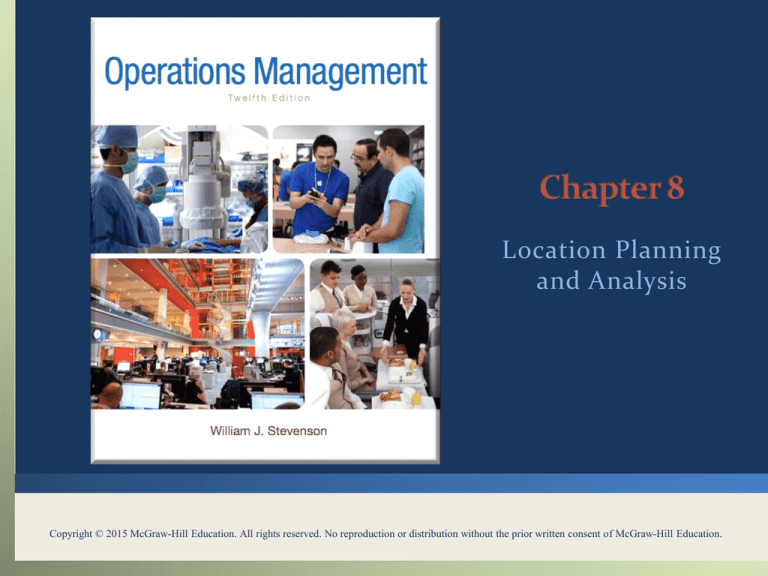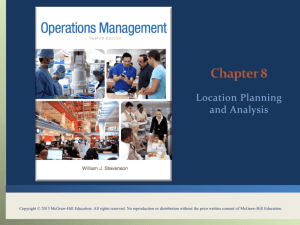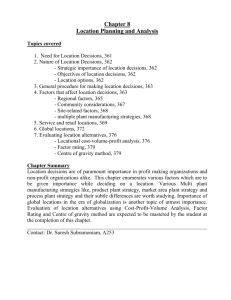
Location Planning
and Analysis
Copyright © 2015 McGraw-Hill Education. All rights reserved. No reproduction or distribution without the prior written consent of McGraw-Hill Education.
You should be able to:
LO 8.1 Identify some of the main reasons organizations need to
make location decisions
LO 8.2 Explain why location decisions are important
LO 8.3 Discuss the options that are available for location
decisions
LO 8.4 Give examples of the major factors that affect location
decisions
LO 8.5 Outline the decision process for making these kinds of
decisions
LO 8.6 Use the techniques presented to solve typical problems
8-2
Location decisions arise for a variety of reasons:
Addition of new facilities
As part of a marketing strategy to expand markets
Growth in demand that cannot be satisfied by expanding
existing facilities
Depletion of basic inputs requires relocation
Shift in markets
Cost of doing business at a particular location makes
relocation attractive
LO 8.1
8-3
Location decisions:
Are closely tied to an organization’s strategies
Low-cost
Convenience to attract market share
Effect capacity and flexibility
Represent a long-term commitment of resources
Effect investment requirements, operating costs, revenues, and operations
Impact competitive advantage
Importance to supply chains
LO 8.2
8-4
Existing companies generally have four options
available in location planning:
1.
2.
3.
4.
LO 8.3
Expand an existing facility
Add new locations while retaining existing facilities
Shut down one location and move to another
Do nothing
8-5
A wide range of benefits have accrued to organizations
that have globalized operations:
Markets
Cost savings
Legal and regulatory
Financial
Other
LO 8.4
8-6
There are a number of disadvantages that may
arise when locating globally:
Transportation costs
Security costs
Unskilled labor
Import restrictions
Criticism for locating out-of-country
LO 8.4
8-7
Organizations locating globally should be aware
of potential risk factors related to:
Political instability and unrest
Terrorism
Economic instability
Legal regulation
Ethical considerations
Cultural differences
LO 8.4
8-8
Steps:
1.
Decide on the criteria to use for evaluating location alternatives
2. Identify important factors, such as location of markets or raw
materials
3. Develop location alternatives
a. Identify the country or countries for location
b. Identify the general region for location
c. Identify a small number of community alternatives
d. Identify the site alternatives among the community
alternatives
4. Evaluate the alternatives and make a decision
LO 8.5
8-9
Locational Cost-Profit-Volume Analysis
Technique for evaluating location choices in economic terms
Steps:
1.
Determine the fixed and variable costs for each alternative
2. Plot the total-cost lines for all alternatives on the same graph
3. Determine the location that will have the lowest total cost (or
highest profit) for the expected level of output
LO 8.6
8-10
For a cost analysis, compute the total cost for each
alternative location:
Total Cost FC v Q
where
FC Fixed cost
v Variable cost per unit
Q Quantity or volume of output
LO 8.6
8-11
Factor Rating
General approach to evaluating locations that includes quantitative
and qualitative inputs
Procedure:
1.
2.
Determine which factors are relevant
Assign a weight to each factor that indicates its relative importance
compared with all other factors.
3.
4.
5.
6.
LO 8.6
Weights typically sum to 1.00
Decide on a common scale for all factors, and set a minimum acceptable
score if necessary
Score each location alternative
Multiply the factor weight by the score for each factor, and sum the results
for each location alternative
Choose the alternative that has the highest composite score, unless it fails
to meet the minimum acceptable score
8-12
Center of Gravity Method
Method for locating a distribution center that minimizes
distribution costs
Treats distribution costs as a linear function of the distance and
the quantity shipped
The quantity to be shipped to each destination is assumed to be
fixed
The method includes the use of a map that shows the locations
of destinations
The map must be accurate and drawn to scale
A coordinate system is overlaid on the map to determine relative
locations
LO 8.6
8-13
If quantities to be shipped to every location are equal, you can obtain
the coordinates of the center of gravity by finding the average of the xcoordinates and the average of the y-coordinates
x
x
i
n
y
y
i
n
where
xi x coordinate of destinatio n i
yi y coordinate of destinatio n i
n Number of destinatio ns
LO 8.6
8-14
When the quantities to be shipped to every location are unequal, you
can obtain the coordinates of the center of gravity by finding the
weighted average of the x-coordinates and the average of the ycoordinates
xQ
x
Q
yQ
y
Q
i
i
i
i
i
i
where
Qi Quantity t o be shipped to destinatio n i
xi x coordinate of destinatio n i
yi y coordinate of destinatio n i
LO 8.6
8-15









